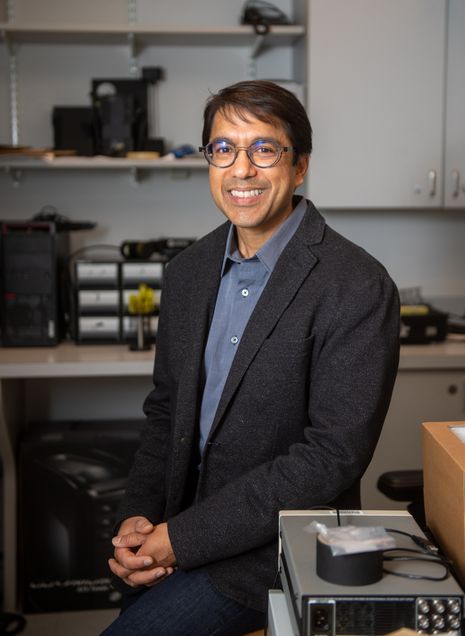Overcoming Instrumental Limits: A New Era in Nanoscale Imaging

In a world where the ability to see and understand the smallest building blocks of life and materials can pioneer new frontiers in science and technology, Professor Vivek Goyal (ECE) and his team have made a breakthrough that could revolutionize nanoscale imaging. Their innovative method for reducing noise in this ultra-precise imaging technique has the potential to transform fields as diverse as biology and materials science. Imagine observing the intricate details of a biological cell or a complex material with unprecedented clarity and accuracy — this is the technological breakthrough Goyal’s research seeks. By overcoming long-standing challenges in the imaging process, this work not only pushes the boundaries of what we can see but also opens the door to discoveries that could shape our understanding of the world at the most fundamental level.
Goyal’s advancement was recently published in the prestigious Proceedings of the National Academy of Sciences (PNAS), a peer-reviewed journal of the world’s most cited scientific publications, covering original biological, physical, and social research.
The research, titled “Shot noise-mitigated secondary electron imaging with ion count-aided microscopy,” represents the culmination of nearly 15 years of work. Goyal credits the inception of this line of work to his early successes in utilizing single-photon detectors in 3D imaging and the speculation of a friend. Karl Berggren, a professor of electrical engineering at MIT, suggested that similar modeling might apply to particle beam microscopy. This idea set Goyal and his team on a decade-long journey leading to their current findings.
Nanoscale imaging, which involves visualizing and studying structures at the nanometer scale (one billionth of a meter), is critical for examining the intricate details of materials, biological cells, and molecules. This level of imaging enables high-precision observation of atomic arrangements, molecular interactions, and other microscopic features, which are vital in advancing fields such as nanotechnology, biology, and materials science.
The main facet of the article concerns “incident ion counting,” a technique that significantly decreases “source shot noise,” a type of random variation in the signal that can obscure details in the image. By cutting down this noise, the method allows for more precise and accurate imaging of nanoscale structures.
Goyal’s research is poised to make a significant impact, particularly in biology and materials science. “In biology, the samples are often fragile, and our methods may ultimately lead to imaging samples previously destroyed by the imaging process. In materials science, our methods may lead to increased resolution for quantitative material characterization,” says Goyal.
While the breakthrough is transformative, the team is still working to improve the speed of the imaging process.
“Our methods currently require the detector not to be too slow relative to the frequency of incident particles. So the slow detectors in current instruments force us to use low beam currents, which makes the imaging itself slow,” Goyal said. “Our overall vision is much broader. We believe we can turn the target shot noise into additional useful information about the sample.”
A key breakthrough in overcoming the limitations of slow detectors came from Akshay Agarwal, a post-doctoral researcher working with Goyal. Initially, Goyal’s team faced challenges in securing support for modifying existing instruments to improve data processing in particle beam microscopes. They believed that reducing complex signals to a single number per scan location caused vital information to be lost. Rather than waiting for someone to build a new instrument, Agarwal realized current detectors, even noisy ones, could be used to validate their theories. This approach led to a breakthrough in reducing noise and enhancing image clarity by eliminating one specific type of noise, even with imperfect tools. Agarwal’s efforts allowed the team to continue their research despite these constraints.
“When we turned our attention to the use of existing instruments, we realized that there are three fundamental sources of noise: source shot noise, target shot noise, and detector noise,” Goyal said. “We can eliminate the source shot noise nearly, and we can do that even when we have to live with high detector noise.”
Looking to the future, Goyal acknowledges that the implications of this research could extend far beyond its current applications.
“Since imaging and visualization are so important in science, this work has potential impacts beyond my imagination and expertise. Our methods fundamentally change the trade-off between image accuracy and sample modification,” he said. “This leads to a possibility of great interest to my group: expansion of the use of heavy incident particles.”
Vivek Goyal is a professor and associate chair of doctoral programs in the electrical and computer engineering department at Boston University College of Engineering. Goyal specializes in signal processing, with a recent emphasis on computational imaging, especially exploiting efficient information representations and developing new imaging modalities dependent on computation. Goyal’s research interests include information representation, statistical signal processing, quantization, and human decision-making and perception.